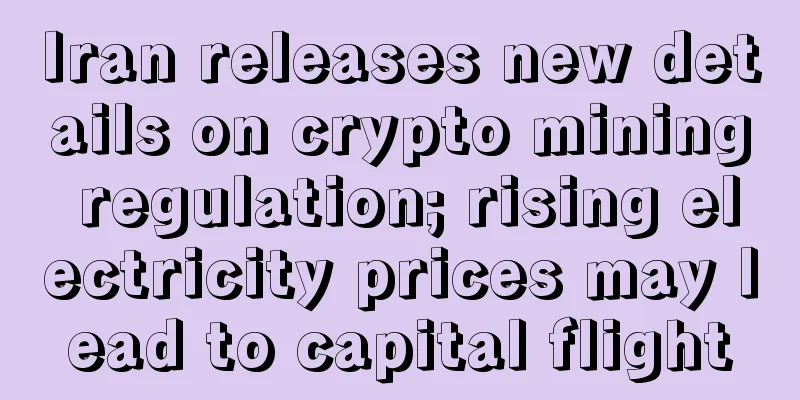Iran releases new details on crypto mining regulation; rising electricity prices may lead to capital flight

|
Since the Iranian government approved crypto mining as an industrial activity in early August, details about the regulatory policies for cryptocurrency mining have continued to emerge. According to recent media reports, the Iranian Ministry of Industry, Mining and Trade is about to release a document that will pave the way for the legalization of cryptocurrency mining for Iranians and foreign citizens. Specifically, cryptocurrency miners who want to obtain legal mining qualifications must obtain two licenses. One is a license for legal cryptocurrency mining business, and the other is a license for operating a cryptocurrency mine. For the pit mining business license, the commercial establishment license is valid for 12 months and can be renewed after the owner provides a subsequent project progress report; the mine must be established on industrial land in accordance with regulations, and the total power consumption of each mine cannot be too low or exceed 30 kilowatts. Mines with lower overall power consumption will not be able to obtain a license, and the model, quantity and power consumption of the mining equipment must also be registered in advance. In general, the Iranian government has introduced corresponding policies to target cryptocurrency mining. The consistent principle is to classify mining business as industrial activities and strictly separate it from cryptocurrency transactions, which affirms the legality of the mining industry. Eliminating regulatory uncertainty should be beneficial to both regulators and the cryptocurrency mining industry in Iran. However, strict regulatory regulations have also eliminated the profit margins of miners using industrial-grade electricity subsidies in the past. It is reported that the Iranian government pays nearly $1 billion in subsidies each year to fill the gap between actual energy costs and consumer spending. It is expected that after the relevant policies are introduced, electricity prices will rise and electricity consumption will be greatly restricted. Coupled with the increase in other expenses such as taxes and mine operating costs, Iran may no longer be the best choice for miners who moved to Iran because of the low electricity prices. After electricity energy prices are no longer competitive, or leading to capital flight, some large mining farms have moved their operations to neighboring destinations, mainly including Russia, Georgia, Kazakhstan, Armenia and even Iraq. The Ministry of Energy has not yet disclosed its electricity export prices to the public. Hamed Salehi, a cryptocurrency and blockchain researcher, mentioned in the report that it is estimated that the price of electricity will reach 5-7 cents per kilowatt-hour. Previously, Iranian miners used industrial-grade electricity subsidies, which were usually less than 2 cents per kilowatt-hour. In contrast, the rates in neighboring countries ranged from 3.5 cents to 5 cents per kilowatt-hour. Salehi believes that the Iranian government is "playing itself into a losing game" because its regulations have the potential to drive many potentially transparent and legal miners underground. He warned that the new regulations could increasingly encourage the emergence of smuggled cryptocurrency miners and prompt many people to mine illegally in their homes. At present, promoting compliance in mining activities is the trend, and losing certain advantages in electricity prices is a reality. However, if we only consider The electricity price is not enough. From a regulatory perspective, the legitimacy of the policy guarantees the sustainable operation of the mines to a certain extent and avoids many potential risks and losses in mining activities. According to media reports, in order to cope with capital outflows, the Iranian National Tax Administration (INTA) once stated that Iranian cryptocurrency miners can obtain tax exemption status if they agree to repatriate overseas income. Although there are many restrictions on cryptocurrency mining at the Iranian regulatory level, there is no final conclusion yet, and there is still a need to find a balance between implementing legal regulation of mining in Iran and preventing capital flight. Source: Caijing.com Chain Finance Author: Xi Xixi |
Recommend
How does a mole on the lower right side of a man's face affect his fortune?
Moles are very common on our body. There are mole...
What does it mean if a girl has a mole on her earlobe? Does it mean she is destined to be rich?
Different moles represent different meanings and ...
How to read eyebrow feng shui
By looking at a person's eyebrows, we can kno...
Palmistry obstacle line fortune telling diagram
In the palm of a person's hand, there is a co...
Bminer Review + Tutorial (ZEC)
Hi all: I would like to share Bminer mining data ...
What does it mean when a woman’s left and right eyes are different sizes?
As one of the traditional physiognomy techniques, ...
500 Lottery Network announced that it will purchase 5,900 Bitcoin mining machines
On February 2, 500 Lottery Network announced that...
What are the characteristics of a woman with the word "wind" on her face? Is this a lucky sign?
What is a wind-shaped face? The face shape is lik...
The country with the largest Bitcoin trading volume is not China, but Japan?
I believe everyone in the cryptocurrency communit...
US Secret Service agent sentenced to 6 years in prison for stealing Bitcoin
A U.S. Secret Service agent accused of stealing h...
What does a mole next to the ear mean?
Many people have moles on their faces, and differ...
Coinfirm and Billon partner to provide blockchain and digital currency trading solutions
Rage Review : Blockchain startup Coinfirm.io and ...
What does it mean if a mole suddenly appears on the hand? What does it mean if a mole appears on a woman’s finger?
Moles in different positions actually represent d...
What are the facial features of people who start to get lucky after the age of 30?
The influence of our face does exist. It can not ...
South Africa’s largest bank joins global blockchain consortium R3
South Africa’s Absa Bank, a subsidiary of Barclay...









